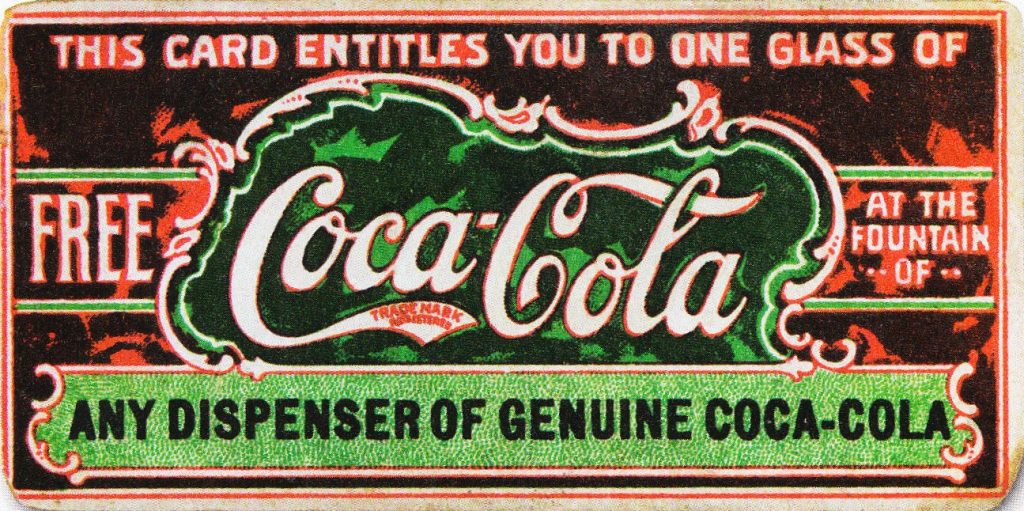
By Coca-Cola Company – Scanned by uploader from Wired magazine (Nov 2010), Vol. 18, No. 11, p. 104., Public Domain, https://commons.wikimedia.org/w/index.php?curid=12726582
Introduction: A Secret Recipe and a Global Icon
A vault door closed with a low thud. Inside was a single sheet of paper—the recipe. In December 2011, Coca-Cola’s secret formula, kept for more than a century in an Atlanta bank vault, was quietly moved to a new home inside the World of Coca-Cola. As then-CEO Muhtar Kent said, staring through the glass wall: “This is not just a piece of paper—it’s the essence of our story.” The vault shut again, and the brand’s history kept flowing.
The First Sip: John Pemberton and the Birth of Coca-Cola
On May 8, 1886, Atlanta pharmacist John Pemberton carried a jug of syrup to Jacobs’ Pharmacy. Mixed with carbonated water, it sold for five cents a glass. Frank Robinson, the company’s bookkeeper, scribbled the name “Coca-Cola” in flowing script. That handwriting still defines the brand today.
Asa Candler: The Marketing Visionary
Businessman Asa Candler transformed a local drink into a national brand. By 1892, he had registered The Coca-Cola Company and plastered the logo on clocks, calendars, and murals. His aggressive marketing and distribution set the stage for growth. A pivotal moment came in 1899, when attorneys Benjamin Thomas and Joseph Whitehead secured exclusive rights to bottle Coca-Cola—turning glass bottles into global ambassadors.
The Iconic Contour Bottle
In 1915, Earl Dean of Root Glass designed a bottle recognizable even in the dark—or from a single broken shard. The patented contour bottle became a design icon, embedding Coca-Cola into memory through touch and silhouette.
The Woodruffs: Coca-Cola Goes Global
In 1919, Ernest Woodruff and his investors purchased Coca-Cola. His son, Robert Woodruff, became president in 1923 and made global expansion the company’s mission. By World War II, he had declared: “Every man in uniform should get a bottle of Coke for five cents, wherever he is.” Mobile bottling plants followed troops worldwide, making Coca-Cola a taste of home and a symbol of victory.
Santa Claus, Happiness, and Advertising Legends
Advertising became Coca-Cola’s second battlefield. In 1931, illustrator Haddon Sundblom created the jolly, red-suited Santa Claus we know today. By 1971, the “Hilltop” ad—with young people on an Italian hillside singing “I’d Like to Buy the World a Coke”—defined an era of unity and optimism.
Experiments, Failures, and Reinventions
Coca-Cola has stumbled. In 1985, under CEO Roberto Goizueta, the company launched New Coke—sweeter, designed to beat Pepsi. Consumers revolted. Within 79 days, “Coca-Cola Classic” returned. The lesson was clear: Coca-Cola wasn’t just a flavor. It was memory, ritual, and belonging.
Ironically, Goizueta’s era was also one of bold expansion: the launch of Diet Coke (1982), global diversification, and immense shareholder value growth.
Coca-Cola in Culture and Politics
Coca-Cola has intersected with history. In 1964, when Atlanta’s elite shunned a banquet honoring Dr. Martin Luther King Jr.’s Nobel Peace Prize, Robert Woodruff intervened: “Coca-Cola doesn’t need Atlanta. Atlanta needs Coca-Cola.” Within days, the event sold out. A brand had nudged a city’s conscience.
Reinvention in the Modern Era
From Share a Coke (2011), replacing logos with consumer names, to Freestyle dispensers (2009) offering 100+ drink combinations, Coca-Cola has embraced personalization and data.
In the 2020s, it expanded into hard seltzers (Topo Chico), RTD cocktails (Jack & Coke with Brown-Forman), and experimental “Creations” flavors like Y3000, inspired by AI and consumer imagination.
Meanwhile, under James Quincey, Coca-Cola streamlined its portfolio, acquired Costa Coffee, and positioned itself not just as a cola brand—but as a global beverage platform.
Challenges and Responsibility
Coca-Cola now sells 2.2 billion servings daily in over 200 countries, but faces scrutiny over sugar, plastic waste, and sustainability. Its “World Without Waste” pledge aims to recycle a bottle or can for every one sold by 2030. NGOs argue progress is slow, but the scale of the company means its actions ripple worldwide.
Conclusion: Selling Moments, Not Just Drinks
From Pemberton’s first syrup jug to today’s futuristic flavors, Coca-Cola’s true product has remained the same: moments. The pop of a cap on a summer day. A sip during a baseball game. The fizz under Christmas lights.
As Quincey puts it: “We are a giant brand, but we must be the smallest choice—always available, right when the consumer wants it.”
The recipe may be locked away in a vault. But Coca-Cola’s story is written in the billions of shared moments, every single day.

By The Coca-Cola Company – Brands of the World, Public Domain, https://commons.wikimedia.org/w/index.php?curid=2270970
